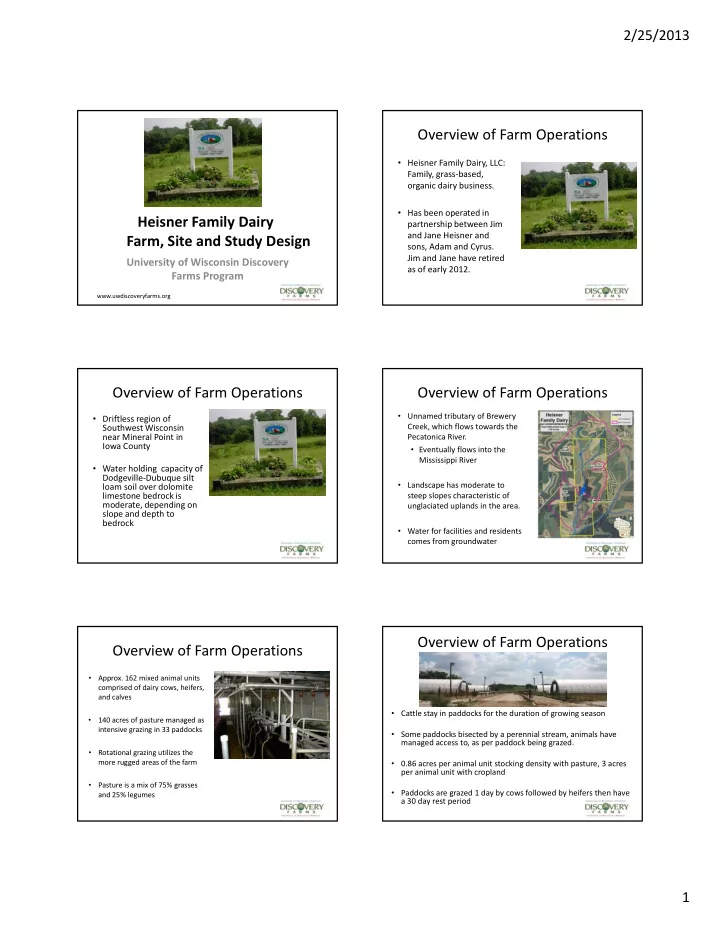

2/25/2013 Overview of Farm Operations • Heisner Family Dairy, LLC: Family, grass ‐ based, organic dairy business. • Has been operated in Heisner Family Dairy partnership between Jim and Jane Heisner and Farm, Site and Study Design sons, Adam and Cyrus. Jim and Jane have retired University of Wisconsin Discovery as of early 2012. Farms Program www.uwdiscoveryfarms.org Overview of Farm Operations Overview of Farm Operations • Unnamed tributary of Brewery • Driftless region of Creek, which flows towards the Southwest Wisconsin near Mineral Point in Pecatonica River. Iowa County • Eventually flows into the Mississippi River • Water holding capacity of W h ldi i f Dodgeville ‐ Dubuque silt • Landscape has moderate to loam soil over dolomite limestone bedrock is steep slopes characteristic of moderate, depending on unglaciated uplands in the area. slope and depth to bedrock • Water for facilities and residents comes from groundwater Overview of Farm Operations Overview of Farm Operations Approx. 162 mixed animal units • comprised of dairy cows, heifers, and calves • Cattle stay in paddocks for the duration of growing season 140 acres of pasture managed as p g • intensive grazing in 33 paddocks • Some paddocks bisected by a perennial stream, animals have managed access to, as per paddock being grazed. Rotational grazing utilizes the • more rugged areas of the farm • 0.86 acres per animal unit stocking density with pasture, 3 acres per animal unit with cropland Pasture is a mix of 75% grasses • • Paddocks are grazed 1 day by cows followed by heifers then have and 25% legumes a 30 day rest period 1
2/25/2013 Overview of Farm Operations Overview Continued • Paddocks are machine accessible for forage cutting and seeding • Sand bedding is used in hoop barns • Pasture is the primary forage source for animals for much of the • Drive ‐ by TMR feeding is year utilized with the hoop barns, supplementing pasture, and for utilized with the hoop barns supplementing pasture and for winter feeding. • More than half of the manure produced is naturally spread by • Collected manure is scraped from hoop barns as needed (often cattle as they graze. daily) and and hauled weekly • During winter, cattle are housed in • Other areas cleaned as necessary four 50 cow free stall hoop barns Overview Continued Overview Continued • Short term manure storage • Tillage is used to control is available allowing weeds flexibility to avoid spreading during inclement weather • Nutrients for crops are provided by manure, • 350 acres of owned and rotated legume hay, and rented cropland are utilized to grow a crop rotation of organically approved corn ‐ small grain ‐ hay ‐ hay. soil amendments Certified Organic. Nutrient Management and Soil Conservation Nutrient Management and Soil Conservation • Nutrient management plan • Estimated 9 tons per acre meets WI NRCS 590 standard of solid dairy manure is deposited on pasture each • Soil and water conservation year, as cattle graze plan shows estimated soil loss plan shows estimated soil loss for all fields ranges from 1 ‐ 3 • The book value ‐ nutrient content for “broadcast” solid dairy tons/acre/year manure that is added back to the pastures is 27 – 27 ‐ 63 pounds per acre (N ‐ P2O5 ‐ K2O) per year • Broadcast applications of solid dairy manure supplies cropland fertilization of 45 – 45 – 105 pounds per acre (N ‐ P2O5 ‐ K2O) over a 4 year crop rotation 2
2/25/2013 Study Purpose and Design Study Purpose and Design • Research conducted from July 2004 thru October 2007 • 2 in ‐ stream sites to monitor • Conducted to gain a better stream water quality understanding of environmental challenges and opportunities for – Upstream (H1) / organic and grass ‐ based dairies in organic and grass based dairies in Downstream (H2) Downstream (H2) configuration the driftless region of southwest WI – The difference between • H3: edge ‐ of ‐ field site to determine sites is the farmstead contributions from cropland on contribution to the the farm stream For Additional Information http://www.uwdiscoveryfarms.org UW Discovery Farms 40195 Winsand Drive 40195 Winsand Drive PO Box 429 Pigeon Falls, WI 54760 1 ‐ 715 ‐ 983 ‐ 5668 jgoplin@wisc.edu or drframe@wisc.edu 3
Recommend
More recommend